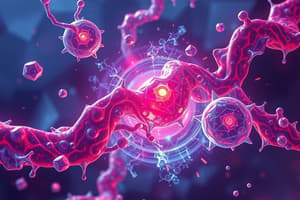Podcast
Questions and Answers
What is the primary role of enzymes in biological reactions?
What is the primary role of enzymes in biological reactions?
- To act as substrates for reactions
- To provide structural support to cells
- To increase the activation energy
- To speed up reactions by lowering the activation energy (correct)
How does the induced fit model differ from the lock-and-key model?
How does the induced fit model differ from the lock-and-key model?
- The lock-and-key model allows for substrate changes during the reaction.
- The induced fit model requires a complementary substrate.
- The active site adjusts its shape to fit the substrate in the induced fit model. (correct)
- The active site remains unchanged in the induced fit model.
What happens to enzymes at temperatures above their optimum level?
What happens to enzymes at temperatures above their optimum level?
- They increase their activity.
- They become denatured. (correct)
- They form more enzyme-substrate complexes.
- They stabilize their structure.
What effect does pH have on enzyme activity?
What effect does pH have on enzyme activity?
Which statement best describes how temperature affects enzyme-substrate complexes?
Which statement best describes how temperature affects enzyme-substrate complexes?
What happens when an enzyme denatures?
What happens when an enzyme denatures?
Which factor is NOT mentioned as affecting enzyme activity?
Which factor is NOT mentioned as affecting enzyme activity?
Why are the effects of low temperatures on enzymes typically reversible?
Why are the effects of low temperatures on enzymes typically reversible?
What is the primary effect of increasing substrate concentration in the presence of a competitive inhibitor?
What is the primary effect of increasing substrate concentration in the presence of a competitive inhibitor?
How do non-competitive inhibitors affect the active site of an enzyme?
How do non-competitive inhibitors affect the active site of an enzyme?
Which description accurately reflects the behavior of a non-competitive inhibitor?
Which description accurately reflects the behavior of a non-competitive inhibitor?
What happens to the reaction rate in the presence of a non-competitive inhibitor when substrate concentration is increased?
What happens to the reaction rate in the presence of a non-competitive inhibitor when substrate concentration is increased?
In what way does increasing enzyme concentration influence the formation of enzyme-substrate complexes?
In what way does increasing enzyme concentration influence the formation of enzyme-substrate complexes?
Flashcards
Enzyme
Enzyme
A protein that acts as a biological catalyst, speeding up chemical reactions by lowering the activation energy.
Active site
Active site
The specific region on an enzyme where the substrate binds and the reaction occurs.
Induced fit model
Induced fit model
The model describing how the active site changes shape slightly when a substrate binds, forming a more precise fit.
Lock-and-key model
Lock-and-key model
Signup and view all the flashcards
Optimal temperature
Optimal temperature
Signup and view all the flashcards
Enzyme denaturation
Enzyme denaturation
Signup and view all the flashcards
Optimal pH
Optimal pH
Signup and view all the flashcards
Enzyme-substrate complex
Enzyme-substrate complex
Signup and view all the flashcards
Non-competitive inhibitor effect
Non-competitive inhibitor effect
Signup and view all the flashcards
Competitive inhibitor effect
Competitive inhibitor effect
Signup and view all the flashcards
Enzyme concentration effect
Enzyme concentration effect
Signup and view all the flashcards
Substrate concentration effect
Substrate concentration effect
Signup and view all the flashcards
Inhibitor effect on reaction rate
Inhibitor effect on reaction rate
Signup and view all the flashcards
Study Notes
Enzyme Function
- Enzymes are proteins with specific tertiary structures
- Active site complements a specific substrate
- Biological catalysts lowering activation energy
- Intracellular or extracellular
- Determine cellular and organism structure and function
Induced Fit Model
- Replaced the lock-and-key model
- Lock-and-key: substrates and enzymes have exact complementary shapes; active sites don't change shape
- Induced fit: active site not fully complementary; slightly changes shape when substrate binds, forming enzyme-substrate complex; stresses/forms bonds in substrate, lowering activation energy
Temperature Effects
- Increased temperature: more kinetic energy, more successful collisions, more enzyme-substrate complexes form
- High temperature: enzyme denatures; breaks hydrogen/ionic bonds between amino acid R groups; active site shape changes preventing enzyme-substrate complex formation
- Low temperature: reversible; high temperature effects are not reversible
pH Effects
- Enzymes denature above/below optimum pH
- H+ (acidic) or OH- (alkali) ions interfere with hydrogen/ionic bonds in amino acid R groups; active site shape changes
Studying That Suits You
Use AI to generate personalized quizzes and flashcards to suit your learning preferences.



